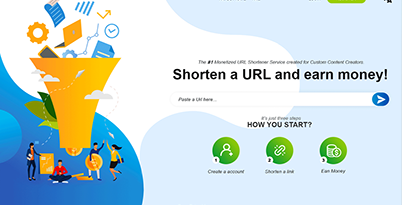YouTube stars are often akin to self-made celebrities — people who have earned an audience by creating content that aims to educate, entertain, review, and just generally be awesome on the internet.
Most YouTubers probably do what they do to scratch an itch for creating and sharing cool stuff, and to get in front of an audience, however small, of like-minded people. If you’re considering starting your own YouTube channel , making money probably isn’t very high on your list of motivations. However, if you’re willing to think strategically about your content, your YouTube channel can actually become quite the moneymaker. Let’s find out how we can make it happen.
INDEX
- 1. How much money can you make on YouTube?
- 2. How to make money on YouTube
- 2.1 Earn directly through the YouTube platform
- 2.2 Sale of products or merchandise
- 2.3 Crowdfunding of your next creative project
- 2.4 Let your audience support your work through “fan funding”
- 2.5 Licensing of Your Content to the Media
- 2.6 Work with brands as an influencer or affiliate
- 3. How to “sell” without annoying your audience
- 4. Are you ready to monetize your YouTube channel?
1. How much money can you make on YouTube?
So how much money can your YouTube channel actually bring in? Basically a lot.
While it is difficult to get reliable figures for the earnings of popular Indian YouTubers, here is a list of the estimated net worth of some of them, in rupees, as of September 2021:
- Gaurav Chaudhary , ₹326 crores
- Amit Bhadana , ₹47 crores
- Nisha Madhulika ₹ 33 crores
- Dra Minati , ₹29 crores
- Ashish Chanchlani ₹ 29 crores
- Bhuvan Bam , ₹22 crores
- Sandeep Maheshwari , ₹22 crores
- Emiway Bantai , ₹18 crores
- Harde Beniwal , ₹16 crores
- Vidya Vox , ₹9 crores
You will probably agree that these are absolutely staggering numbers. While it’s true that all of the YouTubers mentioned above are outliers, it’s equally true that anyone can make any money on YouTube at all if they approach their content creation journey the right way.
Before we discuss what such an approach looks like, let’s quickly tackle some basic questions you may have.
-
Don’t you need lakhs or millions of subscribers and views to make money?
Luckily you don’t! Probably the most important thing you need to know is that even small and mid-sized YouTube channels are monetized on a routine basis. Your earning potential is determined not only by the number of subscribers and views you have, but also by the level of engagement you generate, the niche you cater to and the alternative revenue channels you explore. That’s not to say your subscriber count doesn’t matter – check out our tips for getting more subscribers on YouTube.
Moreover, lists like the one above may give you the impression that the lakhs of rupees some creators make all come directly from YouTube. In fact, many of these channels have their own line of merchandise. But before they could go on to launch their own product lines, they first had to find and build an audience. If making money on YouTube is a goal of yours, the first step is going to be the same as everyone else’s: having a clear understanding of your audience.
-
How do you understand your target audience?
If you don’t already have a YouTube channel, you’ll probably want to first look up the audience demographics of established channels in the niche you’re targeting so you can tailor your content to that kind of audience. However, it seems that comprehensive demographic details for other people’s YouTube channels are not as readily available.
You can definitely get an idea of the keywords and content that resonates with the audiences in your domain through tools like Social Blade and BuzzSumo . However, the analytics they provide will not include critical details such as the age and gender of other channel’s audiences.
So if you want to know what kind of people might be interested in the kind of content you want to create, the best way might be to just start making some content. Because once you have some content, all the demographic insights you need for your own channel can be obtained from your YouTube analytics . Additionally, you can build this initial content around some popular keywords or topics, as indicated by the tools mentioned above.
Building and understanding your own audience will put you in a good position to make money in a variety of ways.
One thing to remember is that when it comes to monetizing your YouTube content, the more niche your channel is, the easier it will be for you to work with brands that want to target specific audiences.

So when looking at your YouTube analytics, pay close attention to:
- The gender of your audience, to see if it skews towards one particular group.
- The age group in which most of your audience falls.
- The geographic location – countries or cities – where your videos are viewed.
- Your audience’s overall engagement, or “watch time”.
With this demographic information at hand, you’ll have a better understanding of your own audience and be able to work with brands more effectively.
-
Can you get paid for just uploading awesome videos to YouTube?
No, you will not be paid for simply uploading videos. In fact, videos are not monetized in any way by default. The simplest way for you to start making money on YouTube is to apply for and be accepted into the YouTube Partner Program . If you are accepted into the YouTube Partner Program, you can enable monetization in your YouTube account settings. This will open up several potential revenue streams for you, such as advertising, channel memberships, YouTube Premium revenue sharing, etc., which are discussed in more detail below. Alternatively, you can also bring in some income if you qualify for the new YouTube Shorts Fund, which is also discussed below.
With those preliminary ideas out of the way, we can now start talking seriously about the different ways your YouTube channel can monetize.
2. How to make money on YouTube
As is the case with making money on Instagram or other similar platforms, you need to explore multiple revenue streams to maximize your YouTube channel’s earning potential.
Fortunately, YouTube makes this relatively simple to do by providing the following ways to bring in income:
- Earn directly through the YouTube platform
- Sell products or goods
- Crowdfunding your next creative project
- Let your audience support your work through “fan funding”
- Licensing Your Content to the Media
- Work with brands as an influencer or affiliate
Let’s take a deeper dive into each of these streams.
2.1. Earn directly through the YouTube platform
The first revenue stream on YouTube you’ll probably want to explore is ads that appear in your videos as part of Google’s AdSense program. To get a share of what advertisers spend on these ads, you must join the YouTube Partner Program (YPP) and enable monetization for your YouTube account. There are several criteria you must meet in order to do this. Two critical things you will need to work towards are that you must have at least 1,000 subscribers, and your channel must have accumulated at least 4,000 public watch hours over the previous 12 months.
● How to enable monetization on YouTube
Once you’ve joined the YPP, here’s what you need to do to turn on monetization for your channel:
1. Sign in to the YouTube account you want to earn
2. Click the icon for your account in the upper right corner
 3. Click YouTube Studio in the drop-down menu
3. Click YouTube Studio in the drop-down menu
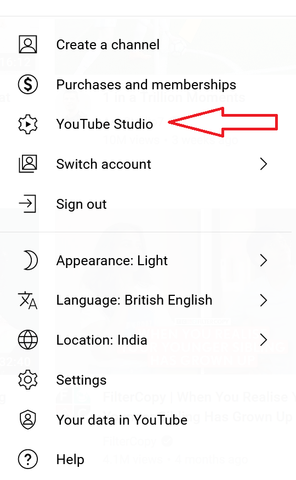
4. In the left menu, click Monetization
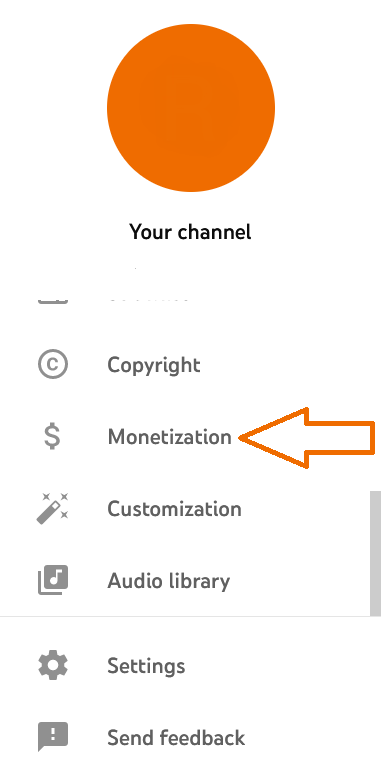
5. Read and agree to the YouTube Partner Program Terms 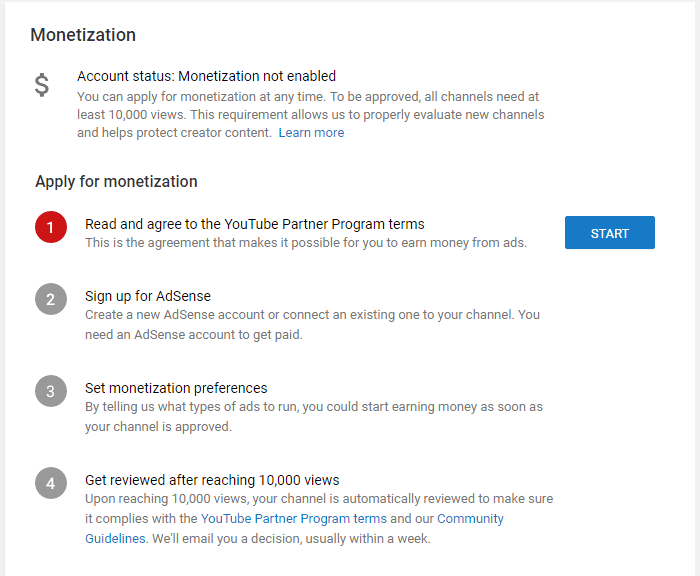
6. Create a new AdSense account or link an existing one to your channel (You need an AdSense account to get paid)
7. Set your monetization preferences
Once done, go back to the dashboard and click on the Analytics tab on the left. From there you will need to select Income from the tabs at the top and then scroll down to the Monthly Estimated Income chart to get an idea of your predicted income.
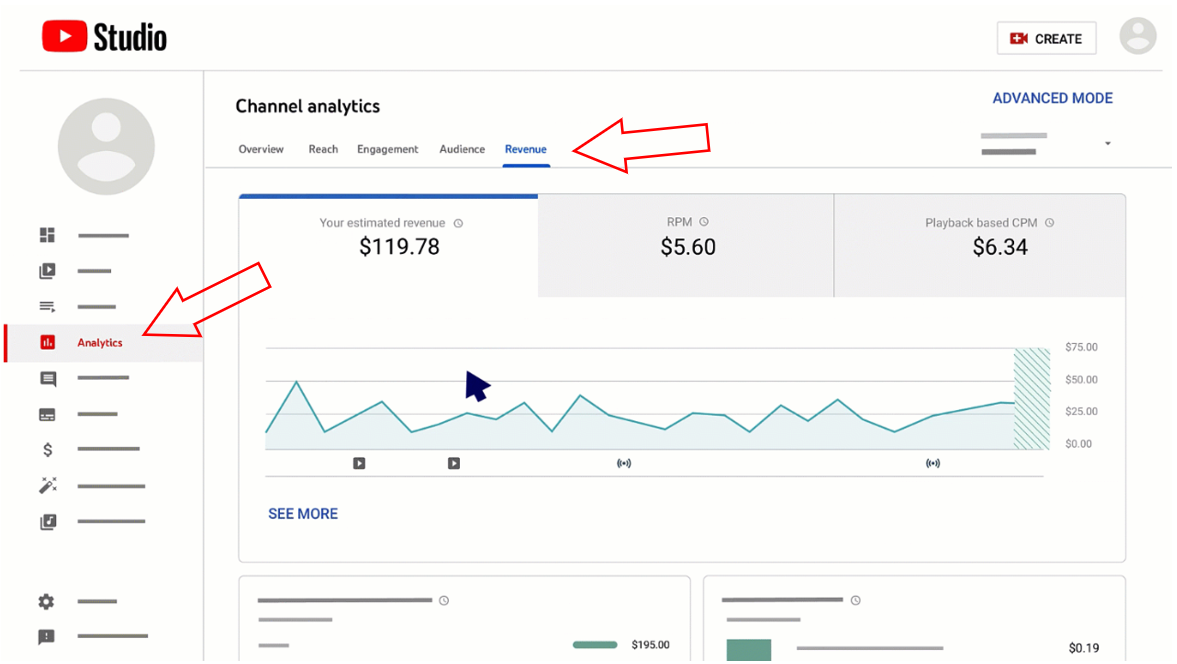
-
How many views do you need to make money on YouTube?
There is no one-size-fits-all answer to this question, as there are many factors that determine how much you make from a video.
For one thing, it depends on the advertising model chosen by the advertiser: CPC (cost per click), CPM (cost per million, ie per thousand views), or CPA (cost per action). Different models result in different earnings from each ad viewed or clicked. Furthermore, the keywords targeting your video, the length of the video and the geographical location of your audience also play a crucial role in this regard.
As a rule of thumb, according to some approximate calculations , if your channel gets 1000 views every day, you can make anything between Rs. 7,500 and Rs. 1,20,000 every month.
However, now that YouTube Premium exists, you no longer have to rely on advertisers creating compelling or enticing ads to earn revenue.
-
YouTube Premium
YouTube Premium is a paid membership program that allows viewers to watch content without any ads, along with a few other benefits. For creators, this represents an additional revenue stream as they will be paid if their content is viewed by YouTube Premium subscribers.
In fact, YouTube shares some of its Premium revenue with creators. How much a creator gets depends mainly on the watch time their channel gets from Premium subscribers.
-
The YouTube Shorts Fund
The YouTube Shorts Fund is a $100 million fund designed to encourage YouTubers to create high-quality shorts (videos no longer than 60 seconds). If you have created a Short within the last six months and are deemed eligible to receive some money from the fund, you will receive a notification from YouTube informing you of this.
Other than creating Shorts and ensuring your channel stays in good standing, you don’t have much control over whether or not you can tap into this income stream. As a result, it would probably be a good idea not to bank on it too much.
-
Why you should look beyond ads for income
Although it’s easy to set up, earning money through advertising as a YouTube partner is far from the most profitable or reliable income stream you can create for yourself on this platform.
For one thing, videos that YouTube moderators or, more likely, algorithms deem not “advertiser friendly” can be demonetized. In other words, they will stop making you any money.
However, it’s important to realize that at the end of the day, it’s possible for some of your content to be demonetized, even if you follow all of YouTube’s rules , without being able to remonetize it. This is already a good reason for you not to rely only on advertising revenue.
Additionally, while ads can be a common way to generate revenue for creators, the tradeoff is that YouTube gets to keep a roughly 45% share of ad revenue .
In short, YouTubers should explore other income streams if they are serious about making money on the platform. Read on to check out some ways to earn money through YouTube without relying on AdSense.
2.2. Sell products or goods
There are many products to sell that can help you make money through your YouTube channel. Selling merchandise — t-shirts, coffee mugs, tote bags, snapbacks, you name it — has an advantage over revenue.
Merchandising increases your exposure by projecting your online brand and personality into the offline world. In addition, it deepens the relationship between you and your fans as they literally “buy into” what you do.
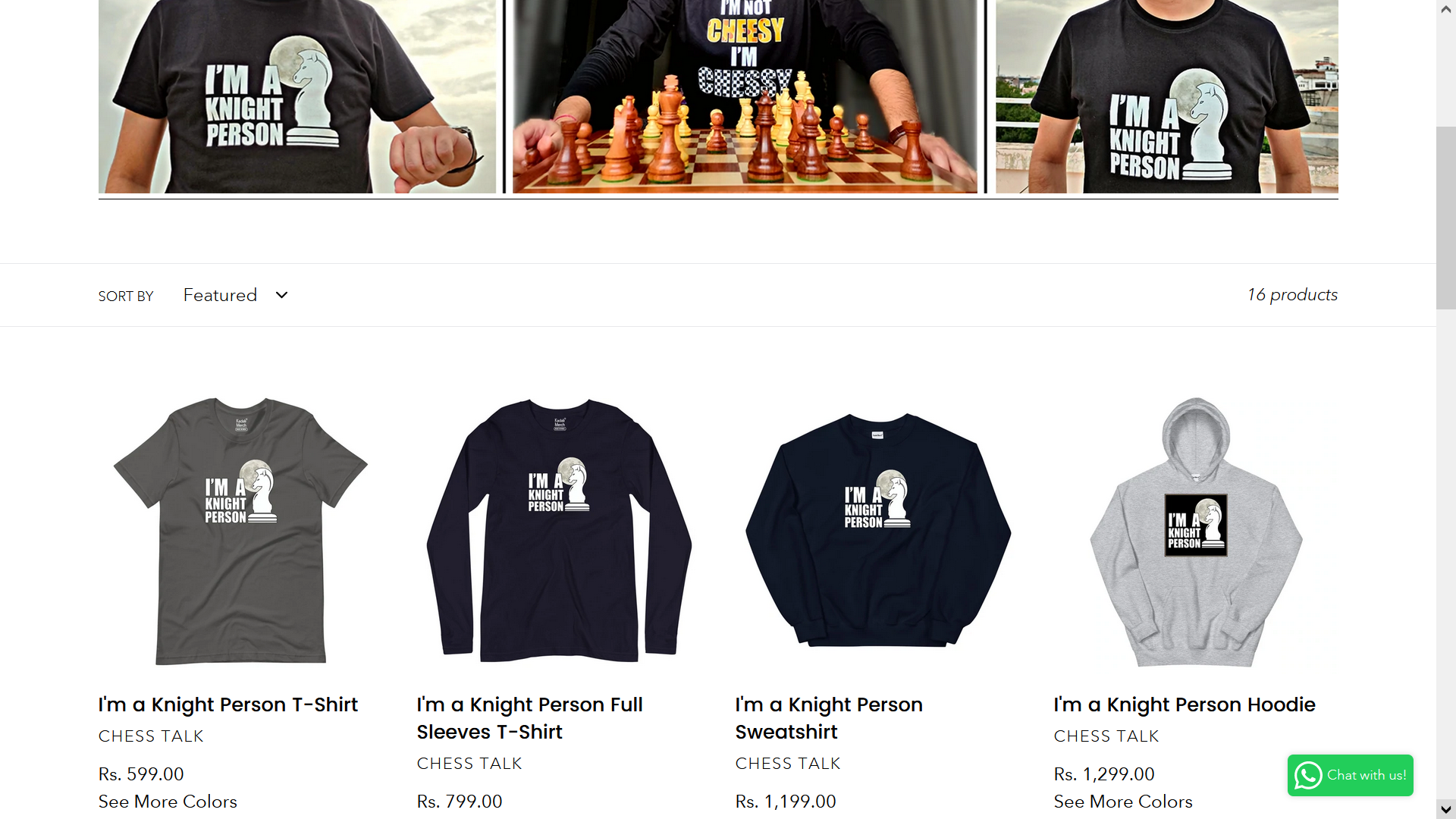
An example of such a YouTube channel is Chess Talk , which sells t-shirts and hoodies through a store called KadakMerch , which only sells merchandise associated with Indian YouTubers.
However, you can absolutely start selling branded products without having to get on such platforms – via your own store.
For starters, you can get affordable designs made for specific products, like t-shirts , using freelance sites like Fiverr . In your store, you can use mockups to give your audiences a glimpse of what the finished products will look like. Finally, to actually fulfill your orders, you can integrate a dropshipping service or a print-on-demand supplier into your store.
You can even go a step further by producing and selling your own unique products and driving your business through your YouTube channel, like Luxy Hair did to sell its hair extensions with hair related video tutorials.
Assuming you’re a YouTuber who’s already built an audience, you’ll have two advantages right off the bat that other store owners are likely to envy:
- A content engine that will consistently drive traffic to your store.
- Your audience’s trust, which you’ve earned by regularly serving them your own branded content for free.
Alternatively, you can partner with an existing merchant network for creators, such as the one mentioned above. However, you should be aware of the fact that by doing this, you will be competing with other YouTubers in the same store. You may also have less control over adding products, offering discounts, integrating your content, and all the other benefits that come with owning your own ecommerce site.
2.3. Crowdfunding your next creative project
When money is all that stands between an idea and its execution, crowdfunding is a great way to make it happen.
Whether you need help buying better equipment, hiring actors or covering other production costs, you can ask your own audience and the crowdfunding community to pitch in if your idea is compelling enough.
Many successful crowdfunded projects tend to offer a teaser or “trailer” that gets people excited, so consider shooting a video that explains your project or offers a taste of what it will be like, like this popular Kickstarter for Kung Fury , a short film that pays homage to action movies from the 80s.
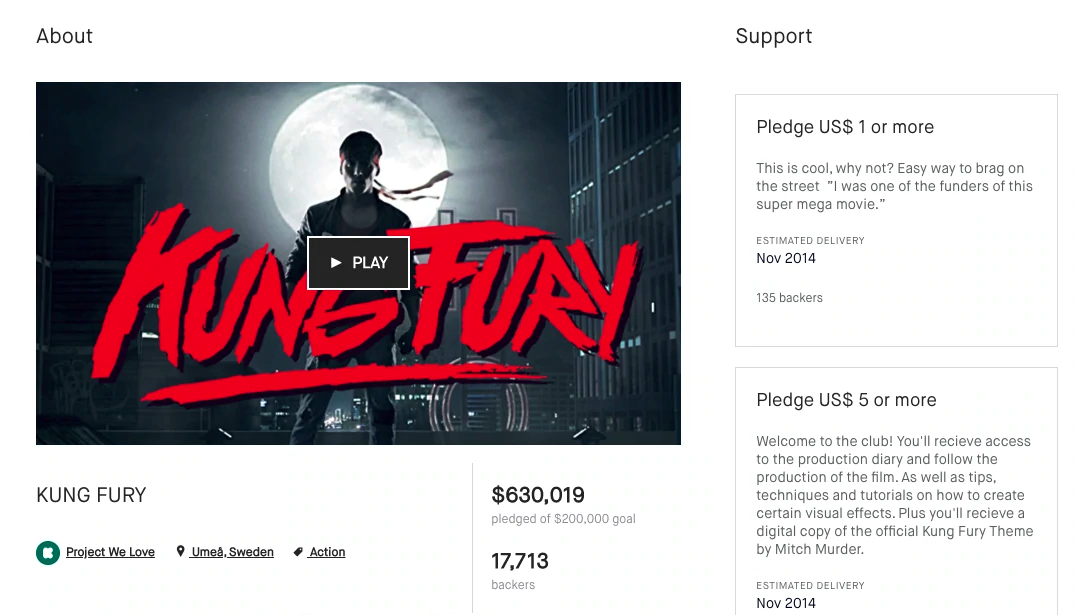
Popular crowdfunding sites with a proven track record of campaigning YouTubers include:
- Kickstarter: One of the most famous crowdfunding sites, ideal for funding cool products and creative projects. Make sure you set an achievable funding goal, as you will only secure it if you actually reach the goal you set.
- Indiegogo: A Kickstarter alternative that offers more flexible funding options.
2.4. Get paid directly by your “fans”.
Similar to crowdfunding a project, you can also set up “fan funding” streams to solicit contributions from your audience, often in exchange for exclusive perks.
As a creator, you contribute your voice to the Internet without forcing your audience to pay for access. So, if you offer good content, your audience may be inclined to support you on an ongoing basis.
Many fan funding platforms offer creators another place for people to discover their content and a way to engage their most loyal audience and reward them for their support.
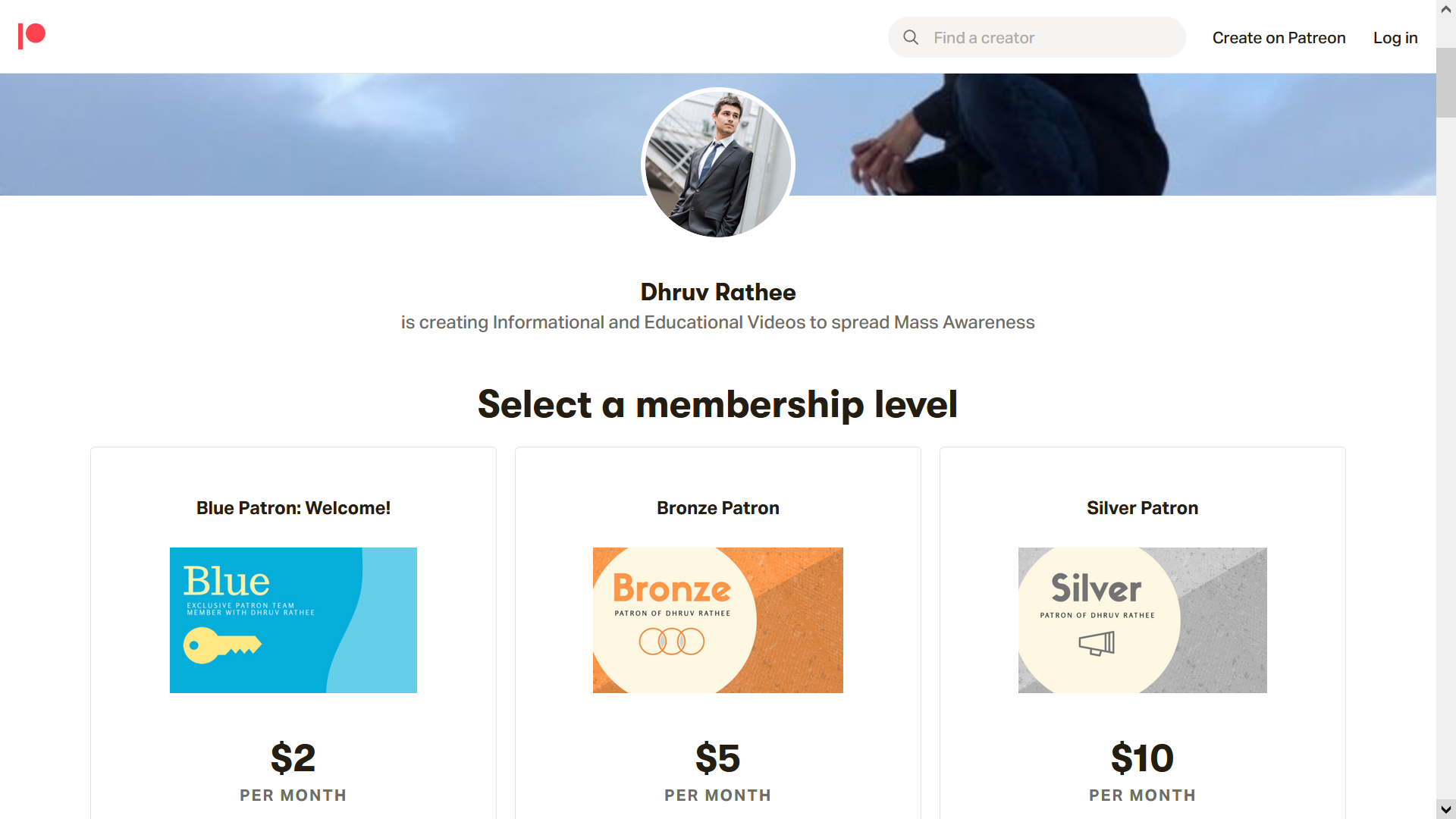
Dhruv Rathee is an example of a famous Indian YouTuber who has a significant number of “patrons” on Patreon, a popular membership platform that allows creators to run a subscription service.
If you choose the fan funding route, be sure to follow some best practices. First, create transparency about how the money will be spent. This will get your fanbase invested in your story or mission, and they will literally buy into the value of your content. Second, offer attractive rewards for better pledges. The more you can make donors feel like they are getting something exclusive for being a loyal fan, the more likely you are to get donations and larger pledge amounts.
Some popular fan funding options include:
- YouTube’s SuperChat: SuperChat is a feature used when you go live on YouTube. It lets you create a tip to which your viewers can donate any amount of their choice whenever they want. You will need to set up your YouTube account for advertising as detailed above
- Patreon : The membership platform that makes it easy for creators to get paid. For as little as a dollar a month, fans can subscribe to their favorite creators and receive exclusive rewards.
- Tipee : Lets you get a combination of both one-time and recurring donations.
2.5. Licensing Your Content to the Media
If you happen to create a viral video with mass appeal—say, a funny clip with your dog—you can license your content in exchange for money.
TV news outlets, morning shows, online news sites, and other creators may be clamoring for the rights to use your videos if they happen to go viral.
You can also list your videos in a marketplace, such as ViralHog , Storyful or Jukin Media , where your content will be easier for the right people to find and buy.
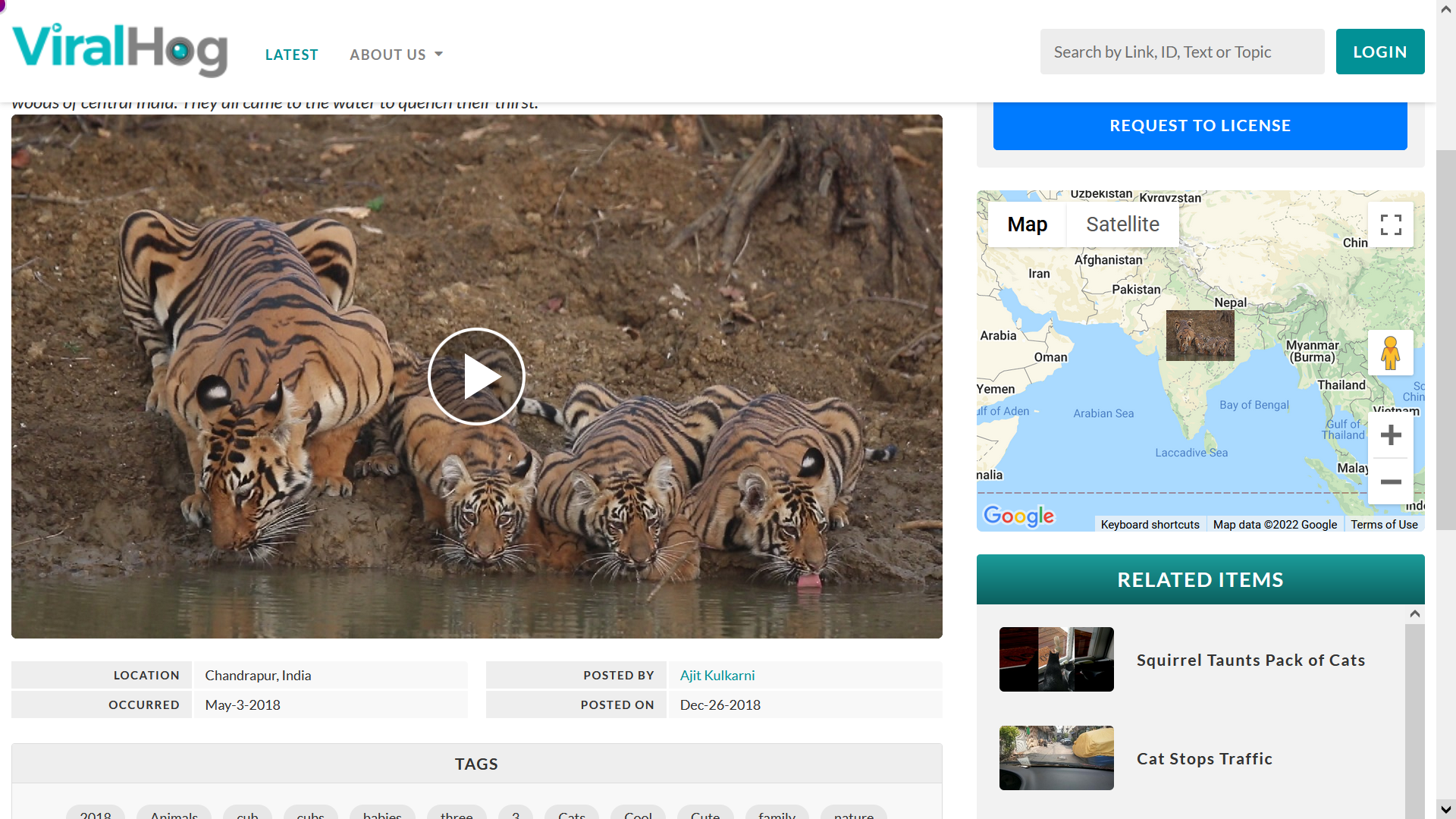
For example, this video of a tiger family received a fair amount of attention online, and was even covered by a few media publications.
2.6. Work with brands as an influencer or affiliate
Influencer marketing is going to be one of the advertising cornerstones of the next decade.
Brands are investing more and more in influencer marketing, spending their typically large advertising budgets on influencers who have already won the loyalty of their audiences.
This creates a massive opportunity for you as a creator if you can negotiate the right deals.
While it’s hard to get reliable data on what Indian influencers typically charge, some estimates put the per-post rate for Instagram at between ₹6,500 (for micro-influencers with 5-10,000 followers) to nearly ₹50,000 ( for influencers with 2.5-5) lakh followers).
If you’re trying to figure out what to charge, a reasonable way to come up with a baseline figure is to take the number of views your videos normally get, and then multiply that number by your average ad revenue per view.
If your channel is already monetized, you can work out this average manually, but if not, you’ll need to estimate it. Probably the best way to do this is to watch videos by content creators in your niche dissecting their earnings. For example, AKS Dusra , who makes videos that help budding YouTubers learn the ropes, worked out that for a certain period in 2020, what YouTube paid him per view was around 0.04 rupees.
Depending on your leverage—used here as an umbrella term for your audience demographics, content quality, how unique and profitable your niche is, reach, audience engagement, and various other factors —you may even be able to negotiate a better deal if the brand is a good fit.
The key when collaborating with brand-sponsored content is to be transparent about it, to not endorse anything you don’t actually like or believe in, and to be honest with your audience about why you’re doing it.
But how do you get a brand collaboration in the first place? There are four main ways to do this:
-
- Reach out to brands with a pitch
- Get brands to approach you by putting out engaging content
- Hire a driver
- Sign up with an agency or influencer marketplace
- Reach out to brands with a pitch
This is probably the most common strategy that influencers use to reach out to brands to get paid collaborations , and it’s easy to see why: you don’t need a large number of subscribers or viewers to go this way. . What you really need is to have a persuasive pitch to send to decision makers.
There are several ways you can use this strategy. One way would be to tag a brand in a relevant social media post and follow up with a direct message expressing your interest in partnering with them. Another thing would be to use LinkedIn to find the PR representatives of brands and then pitch them.
An indispensable component of such an approach is a media kit : it should give brands a quick overview of your style, social media statistics, past collaborations and other relevant details about you.
- Get brands to approach you by putting out engaging content
If you consistently put out content that is of high quality and gets a high amount of engagement, chances are that brands looking to advertise in your niche will sit up and take notice. Once you pass a certain threshold of viewers, comments or perceived influence, it’s very likely that brands may want to reach out to you directly .
To make the most of such opportunities, you should:
-
- Make sure you’re extremely easy to get in touch with by displaying your business contact details prominently on your profile. Consider creating a separate email ID for this purpose.
- Have a process in place to understand project details, such as the brand’s expectations, the payment schedule, the number of posts, etc. A simple Google Forms questionnaire will help.
- Have a media kit ready, of the kind discussed above.
- Hire a driver
Once your audience has grown beyond a certain size, it often makes sense to hire a manager to oversee essential aspects of your business, such as reviewing sponsorship deals, responding to emails and comments, and legal and handle financial matters. This will free you up to do what you need to focus on: creating high quality content.
But managers can also go a step further and actively reach out to brands with whom a fruitful collaboration might be possible. An experienced manager should be able to keep your calendar full without it being overwhelming.
- Sign up with an agency or influencer marketplace
Agencies and influencer marketplaces act as one-stop shops that brands can approach when they need to find the right influencers to work with. While marketplaces make it very easy for influencers to register on their platform, agencies can sometimes be a bit more exclusive, in that they typically reach out to influencers themselves rather than inviting registrations. Regardless, once you reach the database of a market or agency, they will do the heavy lifting of connecting you to brands.
Here are just a handful of the many agencies and marketplaces you can associate your channel with and get discovered by brands big and small:
-
- OPA : Mostly focused on beauty and shopping products. Influencers register on their app and can then participate in invite-only collaborations
- Plixxo : Plixxo will first verify your profile, reach and statistics, after which you can start working on paid brand campaigns. You will need to have at least 5,000 subscribers on YouTube to join here
- in : Boasting thousands of influencers across multiple niches
- Pulpkey : The barrier to entry is less intimidating here: you only need to have 500 subscribers on YouTube to start as an influencer
- Peoplekind : An influencer marketing agency that aims to be “a community of thoughtful storytellers”
Some influencer marketplaces offer you free products, while others are known for having big brands willing to pay more. Capitalize on the opportunities that best suit your needs, but list yourself in as many places as you can to ensure maximum visibility for your channel.
Alternatively, you can also become an affiliate marketer for brands and generate some passive income through commissions from every sale you get through your channel. This works especially well if you review products on your YouTube channel. Since there is no risk on the brand’s end (they only pay when they make a sale), there is usually a low bar to start.
The Flipkart Affiliate Program (4% to 20% commission, depending on the type of product) and Amazon’s affiliate network (earn up to 10% per sale). You can also reach out to brands in your niche that run their own affiliate programs, which is not uncommon in the ecommerce space.
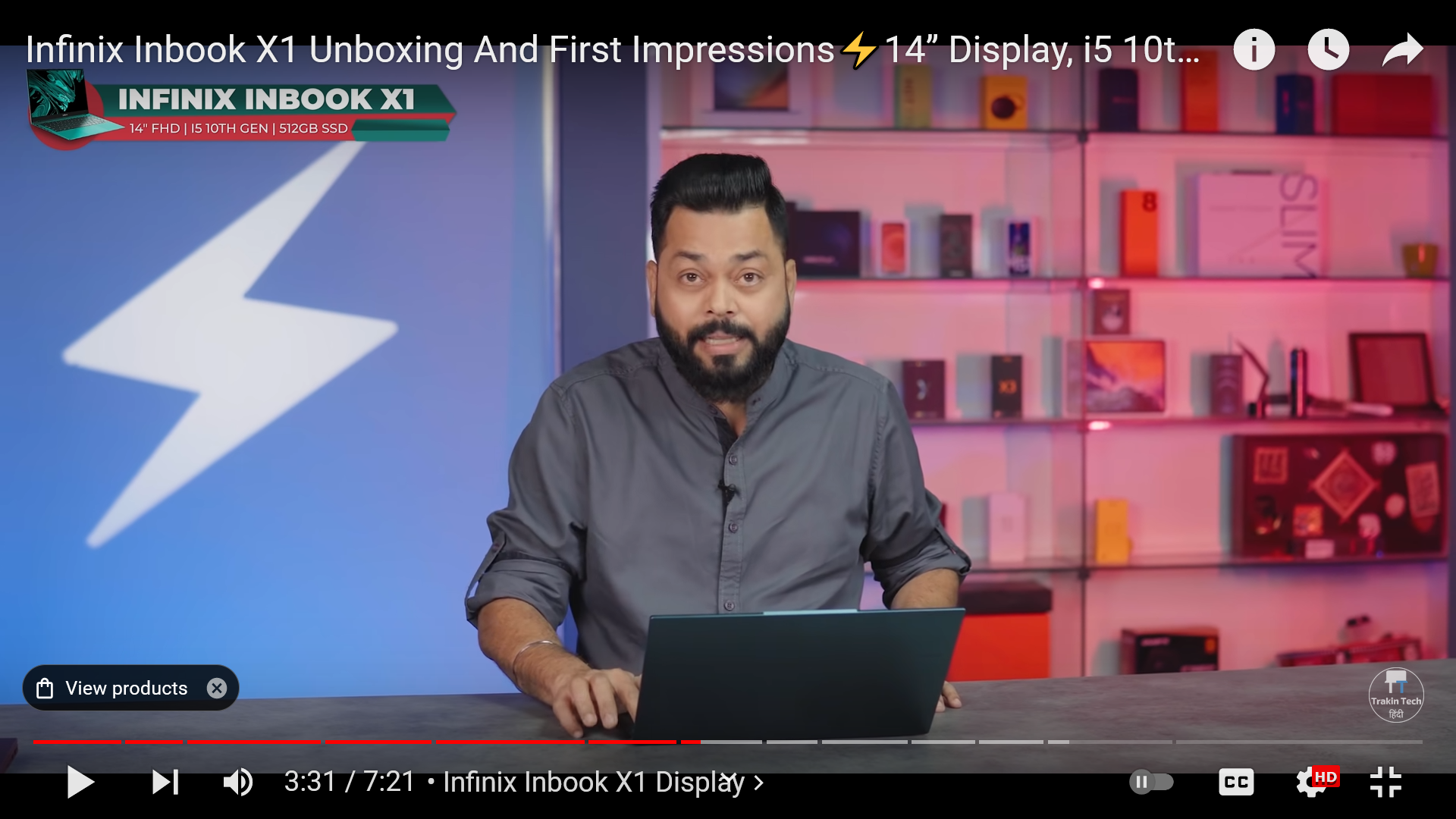
As an example of a YouTube channel that generates income through affiliate marketing, check out Traking Tech , a Hinglish language channel that boasts over 10 million subscribers. Traking Tech specializes in technical product reviews, and it uses affiliate links in its video descriptions to monetize YouTube audiences. The channel is registered as a Flipkart affiliate. It places certain unique links – pointing to the reviewed product on Flipkart – in video descriptions. If a viewer buys the item by clicking on that link, the affiliate will earn a small percentage of the revenue share paid to Traking Tech by Flipkart.
Keep in mind that whenever you promote a brand, product or service in exchange for some kind of consideration, you must make sure to clearly disclose that a certain portion of your content is in fact sponsored, in accordance with the Guidelines for Influencer Advertising set out by the Advertising Standards Board of India.
Finally, there’s an integral but easy-to-overlook aspect of selling to online audiences that deserves its own section: the fact that it’s surprisingly easy to turn people off if they perceive you as a little too eager to separate them of their hard-earned cash.
3. How to “sell” without annoying your audience
Many of the above monetization strategies involve promoting products or campaigns (eg crowdfunding a video series). But you’ll want to make sure your promotions don’t sabotage the integrity of your content.
“Sold out” is a real concern for many creators. But if you never ask, you will never get.
There are a number of common methods you can choose from to promote products or campaigns.
-
Record a call to action in your videos
“If you liked this video, then press the “Like” button and subscribe.”
Many YouTubers include a call to action along the lines at the end of their videos to grow their viewership. By suggesting the intended action you want them to take, your audience is more likely to take it.
You can adapt this approach to direct your audience’s attention to actions that generate revenue for you, such as app downloads or newsletter signups.
-
Add well-timed YouTube cards to your videos
Whether it’s part of your deal with a brand or you’re promoting your own products, YouTube cards provide an eye-catching way to capture the attention of engaged viewers. Cards are rectangular pop-ups that make your videos more interactive. They can contain links to videos, playlists and channels, and even external links.
You can set them to appear at the right moment, when they are most relevant and least distracting, to increase their impact. For example, if you sport a specific watch in a video, you can also have a card with an affiliate link that pops up when the watch is in focus.
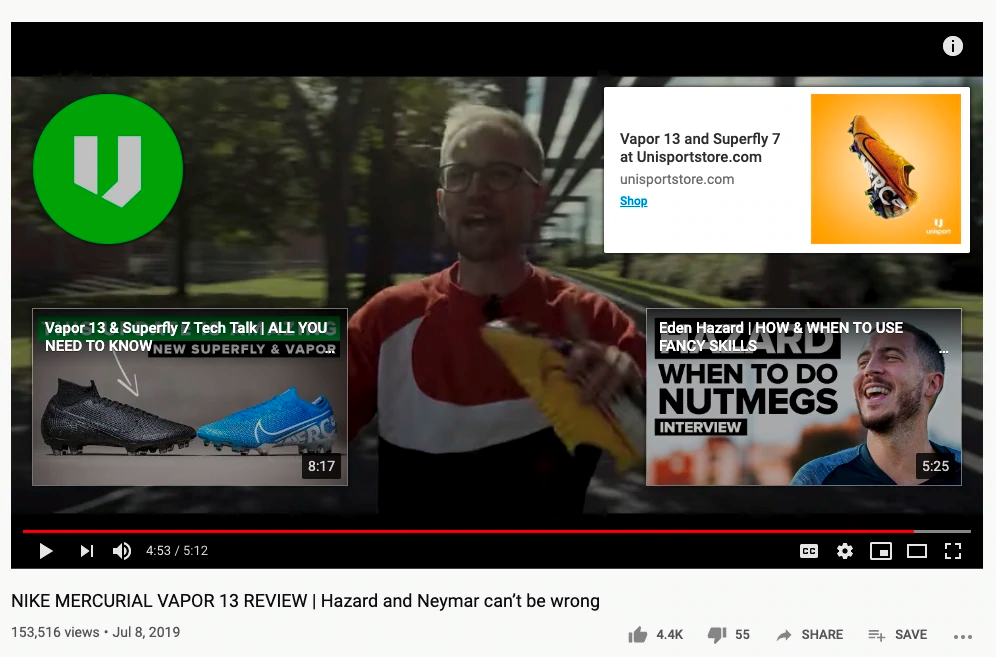
-
Add links in your video descriptions
You can direct viewers to your store, Patreon page, Kickstarter campaign, or other revenue-focused parts of your online presence by adding links in your video descriptions.
If you create videos about your own products and you own or manage a store, you can incentivize new customers to buy your products with buy X get Y promotions or discounts .
-
Promote your offer on other platforms
Just because your content is hosted on YouTube doesn’t mean you shouldn’t take advantage of all the other distribution channels out there.
Spread the word about new campaigns or discounts on Twitter, Facebook and any other profiles of yours.
The more places your message lives on, the more likely it will be seen. So it’s always a good idea to grow your following beyond YouTube with social media marketing .
4. Are you ready to monetize your YouTube channel?
What compels most creators to create is rarely money. It is the thought of making something for the world to enjoy.
But ironically, this puts them in a prime position to actually make money in a content-obsessed world.
While the hard part for many businesses is getting and keeping their audience’s attention, YouTubers already have that bit figured out.
All that’s left is to get creative—to channel the entrepreneurial drive to explore ideas—with how you choose to monetize your passion.
Frequently Asked Questions
1. How can I make money on YouTube?
There are several different income streams that you can take advantage of as a content creator on YouTube:
- Advertising revenue shared by YouTube
- Revenue from YouTube Premium members viewing your content
- Fans who pay through Superchat to have their messages featured in chat streams
- Sell products or goods
- Paid membership through platforms like Patreon
- Licensing Your Content to the Media
- Work with brands as an influencer or affiliate
2. How many views do you need on YouTube to make money?
To start making money on YouTube by joining the YouTube Partner Program, you must have:
- at least 1000 subscribers, and
- at least 4000 watch hours
in the last 12 months.
So, the number of views on your channel is not what counts: what counts is the amount of time people spent watching your videos.
3. How does YouTube send you money?
To get paid by YouTube, you must first create an AdSense account. Within this account, after providing the required details, you will need to select a payment method. Then, once your accumulated income exceeds a certain threshold (currently USD 100, or approximately INR 7,500), you will be paid within a period of 21 days.
4. Do you need 1000 subscribers on YouTube to get paid?
Yes. You need a minimum of 1,000 subscribers and at least 4,000 watch hours in the last 12 months to be eligible for the YouTube Partner Program – which is required to get paid by YouTube.
However, there are other ways to make money on YouTube without signing up for the YouTube Partner Program. This includes:
- apply for the YouTube Shorts Fund
- products or goods sold
- crowdfunding your next project
- direct fan payments through Patreon
- licensing of your content
- work with brands as an influencer
- affiliate marketing
5. Can a beginner make money on YouTube?
Yes, even a beginner can make money on YouTube. However, to get paid directly by YouTube you must join the YouTube Partner Program, to qualify for it you need a minimum of 1000 subscribers and at least 4000 watch hours in the last 12 months.
So a beginner has some other ways to make money on YouTube which include:
- apply for the YouTube Shorts Fund
- products or goods sold
- crowdfunding your next project
- direct fan payments through SuperChat and Patreon
- licensing of your content
- work with brands as an influencer
- affiliate marketing
6. How much money per 1000 views do you earn on YouTube?
Various sources report an average of ₹230 – ₹380 ($3 – $5) as money you can earn with 1000 video views on Youtube.












